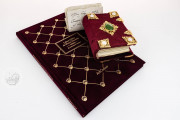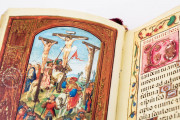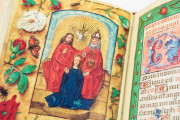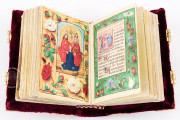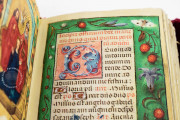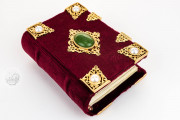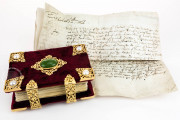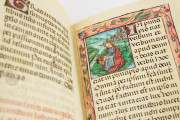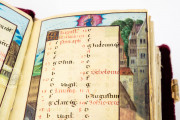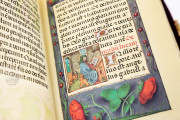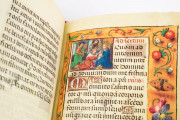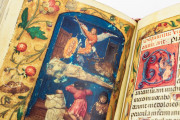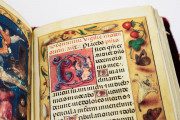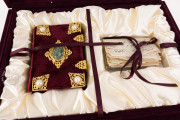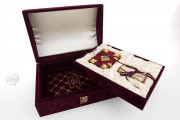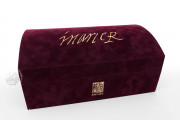The Ravenna Hours of Mary, Queen of Scots, is a tiny Christian prayer book that includes an eighteenth-century inscription associating it with the ill-fated sixteenth-century Queen of Scotland, Mary Stuart, although there is no other evidence to suggest she once owned the book. The manuscript was made in Ghent or Bruges in the early sixteenth century and is illuminated in the characteristic Ghent-Bruges manner. It boasts twenty miniatures with full borders in either the strew-flower style or forming fictive architectural frameworks.
The manuscript is a book of hours, the favored type of book used in personal Christian devotions in late medieval and early modern Europe. At its core is a series of eight prayer services addressed to the Virgin Mary, which—in principle—were recited daily by the Christian faithful.
Shared Compositions and Stylistic Characteristics
In style and the compositions of some of the miniatures and borders, the illumination of the Ravenna manuscript is closely related to the work of the Master of the David Scenes in the Grimani Breviary, especially in two books of hours: the Hours of Joanna of Castile and New Haven, Beinecke Rare Book and Manuscript Library, MS 287.
Images for Contemplation
Most of the full-page miniatures are intended for prolonged contemplation by the Christian believer. The full-page miniature of Christ Blessing, for example, is a fitting introduction to the prayer that opens, "Hail, holy face of our redeemer!": Christ gazes directly out at the viewer as he holds an orb that indicates his eternal power, and the rays emanating from his head suggest the cross of his earthly death. The shared type of berry branch found in the borders of the two facing pages emphasizes the link between the miniature and the prayer (fols. 9v-10r).
Life in Town and Country
The calendar occupies twelve pages (fols. 2v-8r), each devoted to one month. In the painted borders, scenes of outdoor rural seasonal activity occupy the foreground in the lower border—except for the winter months, when indoor activities illustrate the season. Illusionistic townscapes occupy the middle distance of the inner and outer borders, and the appropriate zodiacal sign occupies a reserved area in the upper border.
Prayers and Psalms
In addition to the Hours of the Virgin, the Ravenna Hours contains prayer services focused on the Cross and the Holy Spirit, as well as the Penitential Psalms and the Office of the Dead, all of which are among the most popular inclusions in books of lay Christian piety of the period.
A Rounded Gothic Script
A single scribe wrote the text in Gothic Rotunda, a rounded script often employed in manuscripts made in the Netherlands for export to southern Europe. Each of the major textual divisions is introduced by a full-page miniature on the left-hand page facing a painted initial formed of an illusionistic flowering branch that appears to cast a shadow on a background of a contrasting color on the right-hand page. Both pages boast full borders.
Association with the "Regina di Scozia"
The inscription naming Mary Stuart is in Italian, suggesting that the manuscript was in Italy as early as the eighteenth century. Its current conservation binding of brown leather with gilt tooling dates from the twentieth century.
We have 1 facsimile edition of the manuscript "Ravenna Hours of Mary, Queen of Scots": Libro d'Ore di Maria Stuarda facsimile edition, published by ArtCodex, 2011
Request Info / Price

